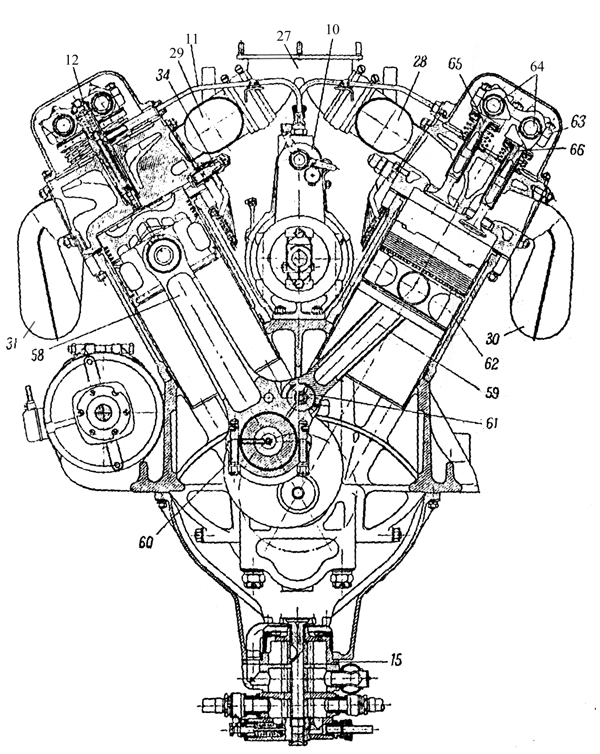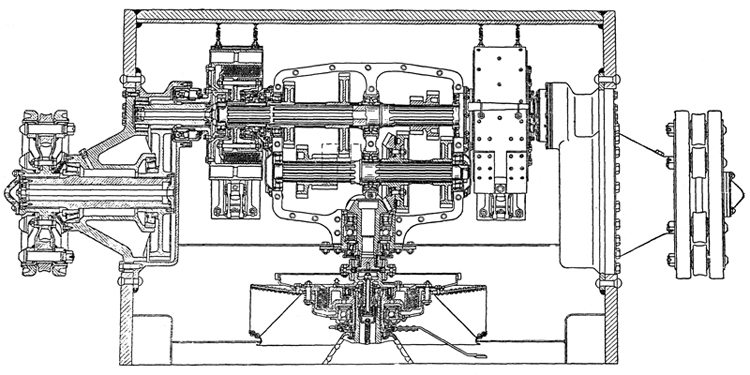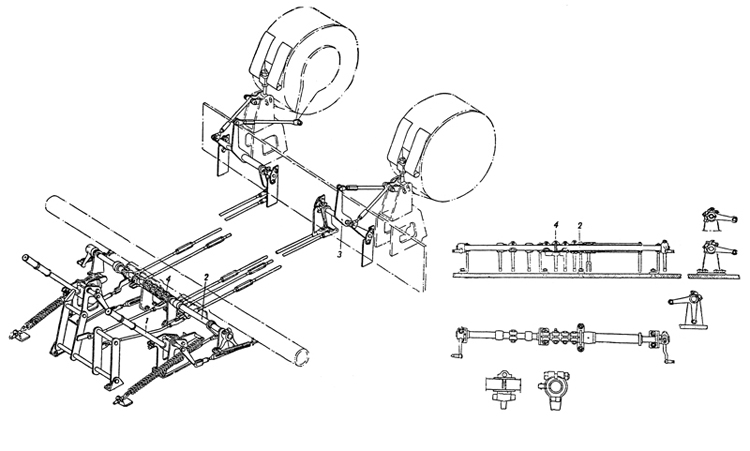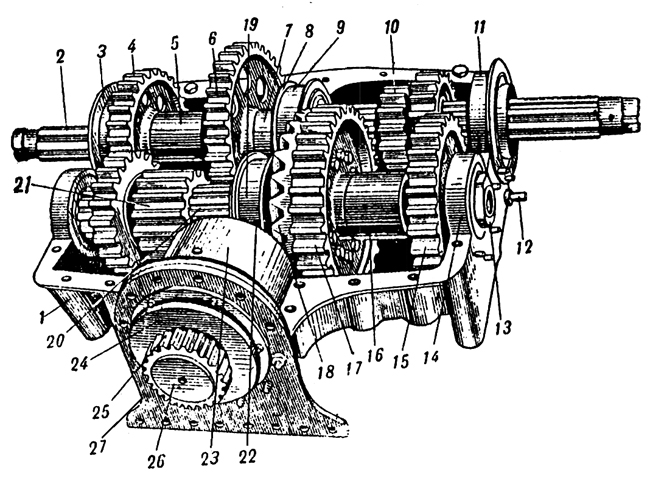T-34:ään saatiin vaikutteita 1930-luvun BT-sarjan vaunuista. Nopeat BT-vaunut olivat kevyesti panssaroituja ja aseistettuja, ne perustuivat yhdysvaltalaisen suunnittelijan J. Walter Christien vaunuihin.
Kyseiset vaunut myytiin Neuvostoliittoon koska Yhdysvaltain armeija kieltäytyi ostamasta niitä.
T-34-vaunussa käytettiin Christie-tyyppistä ratkaisua jousituksessa: jokaisen telapyörän vaappuvivussa oli rungon sisällä oma pystysuunnassa oleva kierrejousensa, paitsi etummaisissa telapyörissä, joissa oli kaksi kierrejousta sisäkkäin. Christien peruja oli myös telapyörästön toteuttaminen suurilla alatelapyörillä ilman ylätelapyöriä, muuten vaunu oli täysin uutta suunnittelua. Uuden muotoilun lisäksi vaunussa oli voimakas V-12 diesel ja maastokelpoiset leveät telaketjut, mikä teki siitä erittäin vaarallisen vastustajan, joka ei syttynyt helpolla tuleen.
T-34:n kehitys alkoi 1936 Stalinin mahtikäskyllä ja prototyyppi valmistui 1939. Sarjatuotanto alkoi kesällä 1940. T-34 oli tarkoitettu korvaamaan keskiraskas T-28-vaunu. Valmistuessaan siinä yhdistyi paras olemassa ollut panssarointi, liikkuvuus ja tulivoima. T-34 oli nopea rakentaa ja helppo huoltaa kentällä. Kaiken kaikkiaan se oli ilmestyessään rintamalle uudenaikaisin ja tehokkain panssarivaunu. T-34:n taistelukykyä haittasi pieni kahden miehen torni. Vaununjohtajan näkökenttä oli rajoitettu ja johtajan täytyi myös toimia ampujana, tosin miehistöä lisättiin myöhemmin viiteen. Radioita ei ollut paitsi komentovaunuissa. Taistelussa osastoa täytyi johtaa käsimerkeillä.
Ensimmäinen malli oli aseistettu 76,2 mm L-11-tykillä. Lisänä oli kaksi 7,62 mm DT-pikakivääriä. Lyhytputkinen L-11-tykki vaihdettiin jo vuonna 1941 valmistuneissa vaunuissa pidempiputkiseen, mutta samankaliiperiseen F-34-malliin. Operaatio Barbarossan alkaessa T-34 yllätti saksalaiset, joiden yleisin pst-tykki, 37 mm:n PaK 36, ei kyennyt läpäisemään T-34:n panssarointia. PaK 38 (50 mm) pystyi lyhyiltä etäisyyksiltä läpäisyyn mutta oli aluksi harvinainen. Sodan alkaessa vain joka kymmenes Neuvostoliiton vaunuista oli T-34-mallia, mutta 1943 puoleenväliin mennessä jo 50–60 %. T-34:n korvattua vanhemmat mallit sen vastineeksi suunniteltu saksalainen Panther ilmestyi taistelukentille. Sitä vastaan suunnattiin Josif Stalin -panssarivaunut.
Myöhään vuonna 1943 T-34:stä alettiin valmistaa mallia T-34-85, jossa oli uusi isompi kolmen miehen torni ja ensimmäistä kertaa erillinen vaununjohtaja. 76,2 mm tykki vaihdettiin 85 mm D-5T-malliin, ja hieman myöhemmin uuteen 85 mm ZiS-S-53:een. Parannettu T-34-85 oli käytössä sodan loppuun ja vielä pitkään sen jälkeenkin.
Vuosina 1940–1944 rakennettiin lähes 40 000 T-34-76-vaunua.
Vuosina 1944–1945 rakennettiin 31 000 lisää T-34-85-mallia. Valmistus lopetettiin Neuvostoliitossa 1946 ja vaunu korvattiin T-44- ja T-54-vaunuilla. T-34:n valmistusta jatkettiin Puolassa ja Tšekkoslovakiassa 1950-luvulle saakka.
Pohjois-Korea ilmeisesti käyttää vaunua edelleen.
T-34:ää on pidetty toisen maailmansodan parhaana kompromissina ominaisuuksien ja mahdollisimman suurien tuotantolukujen välillä.
Early in the war the commander fought at a further disadvantage; the forward-opening hatch and lack of turret cupola forced him to observe the battlefield through a single vision slit and traversable periscope. German commanders liked to fight "heads-up", with their seat raised and having a full field of view – in the T-34/76 this was impossible. Soviet veterans condemned the turret hatches of early models. Nicknamed pirozhok (stuffed bun) because of its characteristic shape, it was heavy and hard to open. The complaints of the crews urged the design group led by Alexander Morozov to switch in August, 1942 to using two hatches in the turret.
The loader also had a difficult job due to the lack of a turret basket (a rotating floor that moves as the turret turns); the same fault was present on all German tanks prior to the Panzer IV. The floor under the T-34's turret was made up of ammunition stored in small metal boxes, covered by a rubber mat. There were nine ready rounds of ammunition stowed in racks on the sides of the fighting compartment. Once these initial nine rounds had been used, the crew had to pull additional ammunition out of the floor boxes, leaving the floor littered with open bins and matting and reducing their performance.
The main weakness [of the two-man turret of a T-34 Model 1941] is that it is very tight. The Americans couldn't understand how our tankers could fit inside during a winter, when they wear sheepskin jackets. The electrical mechanism for rotating the turret is very bad. The motor is weak, very overloaded and sparks horribly, as a result of which the device regulating the speed of the rotation burns out, and the teeth of the cogwheels break into pieces. They recommend replace it with a hydraulic or simply manual system.
The problems created by the cramped T-34/76 turret, known before the war, were fully corrected with the addition of a three-man turret on the T-34-85 in 1944.
---------------------------------------------------------------
Moottori:
V-2 ja V2/34 olivat 12-sylinterisiä V-moottoreita, tyypiltään vapaasti hengittäviä nestejäähdytteisiä suorasuihkutusdieseleitä. Sylinterilohkot olivat 60 asteen kulmassa. Kyseessä on sivukiertokankimoottori, jossa pääkiertokanki oli laakeroitu kampiakselille ja toisen sylinterilohkon mäntien kiertokanget pääkiertokankien alapäähän. Rakenteesta johtuen iskun pituus ja puristussuhde olivat suuremmat oikeassa sylinterilohkossa kuin vasemmassa. Kiertokankien rakenteesta johtuen moottorissa oli noin 1200–1300 kierrosluvulla värinäalue, jota ei saanut käyttää pitkäaikaisesti. Sylinterin halkaisija oli 120 mm.
Iskunpituus oli vasemmassa lohkossa 180 mm ja oikeassa lohkossa 186,7 mm. Puristussuhde oli vasemmassa lohkossa 15 ja oikeassa 15,08. Iskutilavuus oli 38,88 litraa. V-2 oli keskinopea dieselmoottori, teholtaan 500 hv/368 kW 1800 K/min, huippuvääntömomentti 2200 Nm saatiin n.1400-1550 k/min. Käyttökierroslukualue on 1600–1700 ja teho 1700 kierroksella minuutissa 400 hv / 294 kW. Vain hetkellisesti voitiin käyttää suurinta tehoa 1800 kierroksella minuutissa. Suurin vääntömomentti saavutettiin kierrosluvulla 1100–1200. Moottorin suurin kierrosluku oli 2050.lähde?
V-2-moottoria käytettiin T-34- ja KV (Kliment Vorosilov) -vaunuissa, V-2/34-moottoria puolestaan erikoisajoneuvoissa kuten telavetäjissä. Moottori painoi 750 kg. V-2-moottorin kampikammio, sylinterilohko ja sylinterinkannet olivat alumiinia. Kummassakin kannessa oli 2 nokka-akselia, joiden nokat painoivat suoraan venttiileitä. Joka sylinterissä 2 imu- ja 2 pakoventtiiliä. Moottorin kaikki apulaitteet olivat hammaspyöräkäyttöisiä.
Polttoaineen siirtopumppu oli hammaspyöräpumppu ja ruiskutuspumppu 12-mäntäinen rivipumppu, joka sijaitsi sylinterilohkojen välissä. Moottorin käynnistys tapahtui T-34-vaunuissa sähköllä ja varajärjestelmänä oli paineilmakäynnistys. Moottorin käyttöikä on suomalaisten kokemusten perusteella noin 4000 käyttötuntia.
Moottori oli niin edistyksellinen, että sen perusrakenne on yhä käytössä venäläisissä (neuvostoliittolaisissa) panssarivaunuissa, vain apulaitteita on paranneltu ja sijoiteltu eri tavalla. Lisäksi suurimpaan osaan moottoreista on nykyjään laitettu turboahdin. Kyseinen moottori on edelleen myös siviilikäytössä muun muassa laivoissa ja generaattoreiden pyörittäjänä, se on myös saanut suosiota tractor pulling -harrastajien keskuudessa
----------------------------------------------
Voimansiirto:
T-34-76: (1939-1943) Pääkytkin (moottori) 22-levyinen kuiva monilevykytkin. Tämä kuiva monilevykytkin oli T-34:n harvoja herkkiä kohtia. Jos kytkin pääsi hetkeksikään luistamaan, kytkimen lamellit taipuivat eikä kytkin irrottanut levyjään. Tämä tekee liikkeelle lähtemisen lähes mahdottomaksi. Vaihdelaatikko oli synkronoimaton suorahampainen 4+R-siirtohammaspyörävaihteisto.
T-34-85:den (1943-1945) voimansiirto on muuten sama mutta siihen kehitettiin uusi suorahampainen synkronoimaton 5+R-siirtoholkkivaihdelaatikko, joka oli suurimassa osassa T-34-85-vaunuja 1943-45, mutta pieni osa tehtiin myös vanhalla vaihdelaatikolla. Kaikissa sodan jälkeen tehdyissä T-34-vaunuissa oli uudempi vaihteisto.
Ohjausjärjestelmä:
Kytkin-jarru-ohjausjärjestelmän vaihdelaatikosta lähtee kumpaankin telaan oma akseli. Kummallakin telalla on oma kytkin, jolla voimansiirto voidaan katkaista ja näin ohjata vaunua hidastamalla toista telaa. Telan hidastamista tehostetaan tiukassa mutkassa rumpujarruilla.
Alusta:
Kummallakin sivulla keskellä on viisi kierrejousitettua alatelapyörää, ei ylätelapyöriä. Telapyörät olivat yleensä kumitettuja, mutta kumipulan vuoksi niitä jouduttiin tekemään ilman kumia. Edessä kaksoiskierrejousitettu johtopyörä ja takana vetopyörä. Telaketjujen leveys on n. 500 mm. Yhdysvaltalaisessa Christie-tyyppisestä vaunusta kopioidusta edistyksellisestä alustasta johtuen telakenkiä on kahdenlaisia: joka toisessa on vetopyörään keskellä oleviin loviin vastaava harja. Nimenomaan tämä alustatyyppi isoine telapyörineen ja leveine ketjuineen teki T-34:stä niin maastokelpoisen kuin se on.
Sähköjärjestelmä:
24 voltin tasavirta(=laturi). Starttimoottorina työntökiertokäynnistin.
Sodat:
Toisessa maailmansodassa T-34:ää käytettiin itärintamalla vuodesta 1941 alkaen. Pohjois-Korea käytti vaunuja Korean sodassa ja Pohjois-Vietnam, Vietnam sodassa.
Vaunua on käytetty myös Bosnian sodassa.
----------------------------

The T-34 was a Soviet medium tank which had a profound and permanent effect on the fields of tank tactics and design. First deployed in 1940, it has often been described as the most effective, efficient, and influential tank design of World War II. At its introduction, the T-34 possessed the best balance of firepower, mobility, protection, and ruggedness of any tank (though its initial battlefield effectiveness suffered due to a variety of factors).
Its 76.2 mm (3 in) high-velocity gun was the best tank gun in the world at that time; its heavy sloped armour was impenetrable by standard anti-tank weapons; and it was very agile. Though its armour and armament were surpassed later in the war, when they first encountered it in battle in 1941 German tank generals von Kleist and Guderian called it "the deadliest tank in the world."
The T-34 was the mainstay of Soviet armoured forces throughout World War II.
The design and construction of the tank were continuously refined during the war to enhance effectiveness and decrease costs, allowing steadily greater numbers of T-34s to be fielded despite heavy losses. It was the most-produced tank of the war, and the second most-produced tank of all time, after its successor, the T-54/55 series.
By the end of the war in 1945 the T-34 had replaced many light and heavy tanks in Red Army service. It accounted for the majority of Soviet tank production, and following the war it was widely exported. Its evolutionary development led directly to the T-54/55 series of tanks, built until 1981 and still operational as of 2013 and which itself led to the T-62, T-72, and T-90 tanks which, along with several Chinese tanks based on the T-55, form the backbone of many armies even today. In 1996, T-34 variants were still in service in at least 27 countries.
-----
After the battles with the Japanese Army, Koshkin convinced Soviet leader Joseph Stalin to let him develop a second prototype, a more heavily armed and armoured "universal tank" which reflected the lessons learned in those battles, and could replace both the T-26 and the BT tanks. Koshkin named the second prototype A-32, after its 32 mm (1.3 in) of frontal armour. It had an L-10 76.2 mm (3 in) gun, and the same Model V-2-34 diesel.
Both were tested in field trials at Kubinka in 1939, with the heavier A-32 proving to be as mobile as the A-20. A still heavier version of the A-32, with 45 mm (1.77 in) of front armour, wider tracks, and a newer L-11 76.2 mm gun, was approved for production as the T-34. Koshkin chose the name after the year 1934, when he began to formulate his ideas about the new tank, and to commemorate that year's decree expanding the armoured force and appointing Sergo Ordzhonikidze to head tank production.
Valuable lessons from Lake Khasan and Khalkhin Gol regarding armour protection, mobility, quality welding, and main guns were incorporated into the new T-34 tank, which represented a substantial improvement over the BT and T-26 tanks in all four areas.
Koshkin's team completed two prototype T-34s in January 1940. In April and May, they underwent a grueling 2,000-kilometre (1,200 mi) drive from Kharkiv to Moscow for a demonstration for the Kremlin leaders, to the Mannerheim Line in Finland, and back to Kharkiv via Minsk and Kiev.
Some drivetrain shortcomings were identified and corrected.
-------

The T-34 was powered by a Model V-2-34 38.8 L V12 Diesel engine of 500 hp (370 kW), giving a top speed of 53 km/h (33 mph). It used the coil-spring Christie suspension of the earlier BT-series tanks, using a "slack track" tread system with a rear-mounted drive sprocket and no system of return rollers for the upper run of track, but dispensed with the heavy and ineffective convertible drive.
During the winter of 1941–42, the T-34 had a marked advantage over German tanks through its ability to move over deep mud or snow without bogging down. The Panzer IV, its closest German equivalent at that time, used an inferior leaf-spring suspension and narrow track that tended to sink in such conditions.
T-34 Engine. Parola, Tank museo.

10. fuel injection pump
11. High pressure tube to injectors
12. Injectors
15. Oil pump
27. Central tube for inlet manifolds
28 and 29. Inlet manifolds
3O and 31. Exhaust manifolds
34. Starting valve
58. Master rod
59. Articulated rod
60. Big end securing pins
61. Wrist pin
62. Piston
63. Ball bearing of cam shaft
64. Cam shaft
65. Inlet valve
66. Exhaust valve
The air enters into the cylinders of the engine through the central tube (#27), (Plate 9) which is joined to the inlet manifolds (#28 and #29). The products of the combustion are discharged from the cylinders into the air through the exhaust manifolds (#30 and #31).
------------------------------------------

Plate 24 - Transmission of the tank
ENGINE CLUTCH
The engine clutch is multiplate, dry with steel friction plates. It consists of driving and driven parts and a withdrawal mechanism. The operation of the clutch from the driving compartment is carried out by means of a linkage (Plate 26).
------------------------

Plate 36 - Layout Of The Steering Clutch And Brake Controls
1. Steering lever with compensating mechanism
2. Compensating shaft
3. Transfer shaft
4. Foot bake control
The steering lever (#1) pivots on a shaft fixed in a bracket. This actuates a small lever (#4), of the foot brake linkage. This small lever is joined to the brake band through other levers connecting to the compensating shaft, tie-rods and levers of the transfer shaft.
The steering levers terminate in hooked levers, the internal working surfaces or which are ramped and bear against rollers fixed to a forked lever which is pivoted in the bracket. (Plate 37) One end of the forked levers is connected to a return spring and the other end to the control rod of the steering clutch. This tie-rod is connected through the compensating shaft, long tie-rod, transfer shaft and control lever to the control box of the steering clutch.
The connections between the separate components of the control linkage are shown in Plate 36.
The foot brake control consists of pedals, pedal tic-rods with two projections. One end of the pedal tie-rod is connected to the pedal and the other end to a small control lever (#4) which moves freely at the end of the two compensating shafts.
Action of the steering Control
When the steering lever is in the extreme forward position, the force of the compensating springs is transferred through the rollers to the bracket. On pulling the steering lever backwards the spring pulls the forked lever forwards and disengages the steering clutch. When the roller reaches the end of the ramp of the hook the disengagement of the clutch is completed and the force of the clutch spring is transferred to the bracket. All the force exerted by the driver is now used to operate the brake. A fixing device is provided to hold the brakes on.

Plate 27 - General View Of The Gearbox (Without The Top Half Of Its Case)
1. Casing, lower half
2. Main shaft
3. Outer race of main shaft bearing
4. Fixed gear of 2nd speed
5. Spacer bush
6. Fixed gear of 1st speed .
7. Spacer bush
8. Ring of cover of conical bearing
9. Cover of conical roller bearing of central support
10. Moving gear train for 3rd and 4th speed
11. Cover of roller bearing of outside support
12. Limiter of control box for disengaging steering clutch
13. Nut
14. Roller bearing of outside support
15. Fixed gear of 3rd speed
16. Spacer bush
17. Fixed gear of 4th speed
18. Driven bevel gear
19. Cover of intermediate shaft
20. Intermediate shaft
21. Moving gear train for 1st and 2nd speeds
22. Driving bevel gear
23. Cover of driving shaft
24. Gland nut
25. Geared coupling
26. Plug
27. Bracket

As of 2012, the T-34 is mostly in reserve, used in a light tank role, or treated as an infantry backup.
In some Third World countries, it is also considered a secondary or even primary tank where more modern tank designs have not entered service yet.
The following countries have used the T-34. As of 1996, it remained in service in 27 of those countries, indicated by asterisks.
Europe and the Americas
|
Middle East and Asia
 Afghanistan
Afghanistan Cambodia
Cambodia Indonesia
Indonesia Iraq
Iraq Iran
Iran Israel - Captured
Israel - Captured Laos
Laos Lebanon
Lebanon Mongolia
Mongolia North Korea - Still in limited use by reserve armoured training regiments.
North Korea - Still in limited use by reserve armoured training regiments. Palestine – 12 operated by the PLO in Lebanon, passed on to the Al-Murabitun militia.
Palestine – 12 operated by the PLO in Lebanon, passed on to the Al-Murabitun militia. Pakistan
Pakistan People's Republic of China
People's Republic of China South Korea - Captured three T-34-85 during Korean War. Two were destroyed, only one left.
South Korea - Captured three T-34-85 during Korean War. Two were destroyed, only one left. Syria
Syria Vietnam
Vietnam South Yemen
South Yemen North Yemen
North Yemen
Africa
 Angola
Angola Republic of the Congo
Republic of the Congo Egypt
Egypt Equatorial Guinea
Equatorial Guinea Ethiopia
Ethiopia Guinea
Guinea Guinea-Bissau
Guinea-Bissau Libya - Alleged to have been used by Pro-Gaddafi forces in final stages of Libyan Civil War.
Libya - Alleged to have been used by Pro-Gaddafi forces in final stages of Libyan Civil War. Mali
Mali Mozambique
Mozambique Namibia
Namibia Somaliland
Somaliland Somalia
Somalia Sudan
Sudan Togo
Togo Zimbabwe
Zimbabwe









Hyvä artikkeli mainiosta tankista.
VastaaPoistaItse kasasin kolme vuotta sitten yhdestä lontoon murteella kirjoitetusta tieto-opuksesta tämmösen.
http://iluvon66war.blogspot.fi/2011/10/fighting-vehicles-of-eastern-front-t-34.html
Huomenta IlluVon66
VastaaPoistaKyllä, juuri tämä oli se vaunu jonka kehityksellä Neuvostoliitto harppasi Länsi-Valtoiihin nähden vuosikymmeniksi eteenpäin.
Suurin ansio oli tuo V-2 moottori, jossa yläpuoliset nokka akselit, alumiini kannet, ja moni (4) venttiili per sylinteri.
Tämä moottori oli liian heikko yli 40 tonnia painaviin vaunuihin, mutta sopiva T-34 tankkiin.
Lisäksi T-34 tankki oli sokea, etenkin lähitaisteluissa, joka oli sen suurin heikkous
ja esiintyi kaikissa Neuvostoliiton vaunuissa aina T-50 sarjaan asti.